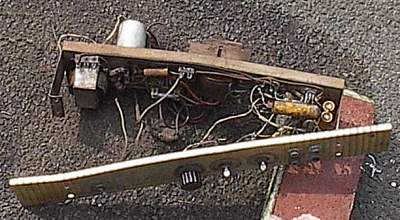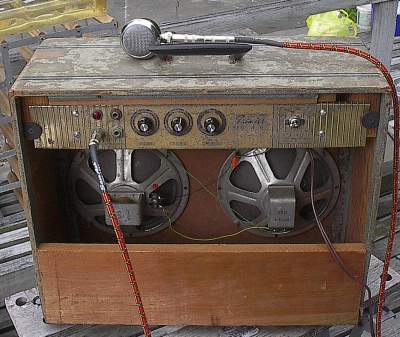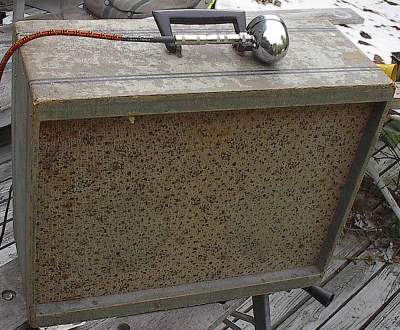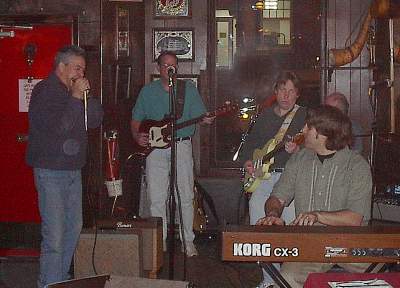Premier Twin-8 Project
About a year ago I
bought a Premier Twin-8 Chassis. This rusted hulk had sat on someone's back
porch for 5 years. The tubes and speaker had been robbed and the cabinet had
gone the way of the back porch - termites. The chassis was a rusted, dirty,
greasy pile of wires and unreadable parts. It had the original catalan knobs
and it appeared to be mostly there, but without a schematic, I didn't have much
hope of restoring it.
Recently someone sent me a twin-8 schematic - the right one. Premier made the twin-8 with a 6x4 rectifier tube and a tubeless rectifier version. Both are cool amps, but the solid state rectifier ones date from the early 1960's. Mine was an original with the rectifier tube. Date codes on the transformer and the capacitor can indicate that the manufacture date was no earlier than 1958.
Well, I took it out
back and washed it out with naptha and degreaser spray and it began to look
like an amplifier. This amp is made with an open chassis, the front panel is
attached to a flat piece of sheet steel with brackets. Parts are soldered from
the pots and sockets directly to the chassis components. These connections were
mostly pulled appart when the chassis had been unscrewed from what was left
of the cabinet.
I replaced most of the electrolytic caps with orange drops that I had bought by the dozen at a flea market. I put the big blue 20uf Sprague Atoms in to replace the ones in the can. The 20/25 uf cap off the 6L6 got replaced with a 25/25 from a dozen I bought from mouser.
I resoldered the connections from the front panel to the chassis, this time with enough extra wire to let me easily break it down without any strain on the components.
I resoldered as many of the really corroded spots that I could find. I put in a new 10 foot power cord (I buy the cheap brown extension cords from home depot and cut their heads off). I didn't go to a three prong plug. (I know - I should have as long as I was working on it.)
I pulled off the original catalan knobs. I am going to sell them either on this page or on ebay to pay for the project. The amp's cosmetics really suck and there is no sense in keeping the original knobs. I went over to my brother's and stole a 6V lamp from his stash so at least the power light would tell me if the thing was trying to work.
I hooked a speaker up to the speaker wires and then tickled the wrong side of the output transformer with the ohm-meter. The voltage scratches went through the transformer and I heard them on the speaker, so the output tranny was at least trying to work.
The only unkown was the power transformer.
I tubed it with oldies but goodies from my tube stash.
I placed a fire extinguisher within easy reach.
I plugged the amp into my Variac and turned on the amp. I slowly went from 0 to 40 volts. There was no smoke, no lights, no nothing.
Up to 80 volts - nothing. Up to 100 volts nothing. I put it back down to 50.
I carefully probed with VOM set to 1K and there was narry a wiggle on the needle. I set the VOM to 250 and still nothing. The power cord showed 50 volts and the switch actually worked. I then went to the fuse - nothing. THE FUSE WAS DEAD.
I had worked for three hours on the thing and never thought to replace the fuse!
After replacing the fuse I again powered up to 50. There was light in the power lamp and the 6X4 was starting to glow a little. The speaker was silent. I wiggled the 6v6 and I saw the start of some glow. The 12AX7's are very faint, even at full power so I tried bring up the voltage to 80.
The speaker made a slight hiss. The old tubes were talking to me. I plugged in a mic and started turning up the volume. FEEDBACK! The little 6 inch speaker started to yell. I turned it back down. "Testing... Testing..." It was ALIVE!!!!
Not only alive, but it sounded good. I unhooked the mic and turned up the volume all the way. The hiss was a little louder. I turned the tone control all the way up and got a touch of hum.
I risked bringing it up to 120 volts for a few minutes and there was no smoke and no additional hiss. I brought the voltage on the variac down to 80 volts and I left the thing to cook for a while. An hour later and she stilled sounded good. I brought it up to 100 volts and let it sit another hour. No problems. The 6L6 and the 6X4 seemed warm to me, but not unreasonably so. The next morning I plugged it in with no variac out on the porch and it sat happy for the next 4 hours. Ladies and Gentlemen we have an amp!
Note: If your cats won't come when called, they will also ignore your voice when amplified so the whole neighborhood can hear you call "here, kitty, kitty".
Next, I needed a cabinet
about 18 inches wide and 7 inches deep with two 8 inch speakers. As luck would
have it, I have a friend who is as avid a junk picker as myself. Jim Holland,
a great drummer, found an amp at the side of the road. It has a faded green
vinyl covering with blue pinstripes. The grill cloth has that paint drizzle
design that you found in 1970's amps.
The original chassis - which would have be attached vertically on the side was gone and replaced with an "no-name" one. It had one tube, a 6BQ5 and two other empy sockets and two eight inch speakers. It had been rained on and then it sat in my brother's barn for a couple of years until I pulled it out and brought it home. I could never get it to work. I tried all combinations of tubes, but I could never get it to make a sound - not a hum or a hiss. Voltage is good, and output tranny is good.
The speakers worked. and were each 8 ohms which is right for the twin 8. The cabinet it cheap plywood and particle board, but it is 18 inches wide. I pulled the old amp chassis and put it away for future consideration and built a shelf for the Premier chassis.
Here are some pictures.
I have the ugliest twin-8 in history, but it has a sweet sound. This is the
loudest single end amp that I have ever heard. The 6L6 going through the two
8's is deadly. With only the single 6L6, it will not cut through the guitar
amps, so it must be mic'ed, but the two 8 inch speakers give it lots of "balls"
and the 12AX7 tubes have a great overdrive when you plug in a crystal mic. It
can be sweet or dirty as you like, just by cupping the mic a little differently
and driving those low draw notes a little more.
It is a little noisy, either an old resistor going bad or the ancient used tubes are going bad. But since it is also very loud, the hiss is not noticeable. I am not going to spend money and retube it.
The parts are packed in tight, and when I first assembled it, there was a crackle every time you moved the amp. The power light was touching against the bottom of the 12AX7 socket due to the bent up chassis being so out of allignment. I taped it and now it doesn't crackle any more.
One more thing, the tremelo works. Someone had replaced the 100 uf tremelo cap with two 50uf caps and they had broken off. I put a small (35v) 100 uf cap back in and the tremelo started up. It is a nice subtle roll - about 8 beats per second. It sounds very cool with harp, a little like a smooth throat vibrato. There are no controls for the temelo other than off and on. No speed or intensity.

Carlos Colina at the Roxy Perry's Jam in Tarrytown, NY. He's playing throught
Twin-8. I was a the back of the room and although I could hear him, he was not
as loud as the guitarist. He later switched to the Premier B-160 behind it,
because Chip Larrison (guitarist) was too damn loud.
